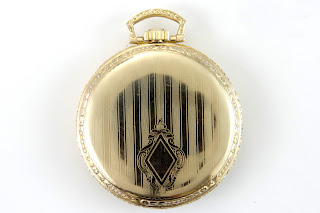 |
| J.W. Benson 17J half hunter 1878. |
In the case of P & A Guye it is largely because they supplied almost entirely to the trade and disappeared from Kelly's guide as a watch maker after 1905, but they are known to have stayed in business, related to the watch trade until at least 1932.
I am rapidly firming up my belief that they ended up as sub contractor to, a partner of or even as a subsidiary of Benson.
 |
| An unrestored movement signed by P & A Guye, |
The first thing to do is to establish what Max Cutmore was unable to do in his work [1] and that is to establish if Benson were customers of P & A Guye and if possible to go a bit further.
The watch movement shown to the right is clearly signed by P & A Guye, 13, Northampton Square, London.
It is rare and the first I have seen signed by the company, Max Cutmore [1] stated in his coverage of the company that he had been unable to positively identify any movement by the company, although there were some possibilities.
It is a size 12 hunter movement with 19 jewels, unfortunately I can't date it as it came without a case, here is a view of the face plate:
 |
| The face plate of the unrestored P & A Guye movement shown above. |
 |
| J.W. Benson 17J half hunter, 1878. |
Clearly these are from the same maker, or at least of the same design, and that is confirmed by other factors such them having the same train layout, the same construction of components and the use of the same type of cap jewel. The real differences are that the Benson movement is a smaller, scaled down, version and that if has 17 rather than 19 jewels.
P & A Guye very rarely sold under their own name and would not have purchased a Benson made watch and branded it as theirs, it therefore follows that P & A Guye made for J.W. Benson in the 1870's.
QED!
Who "owned" the design is not however clear as Guye could have made movements for Benson and under licence to sell on to third parties.
The "Field" & "Ludgate" watches.
Now check out the face plate of this Benson "Field" of 1899:
 |
| J.W. Benson "Field" 13J, 1899. |
This movement has the Benson patent dust ring and whilst it is clearly not the same movement as the ones shown above the similarity of the face plate and winding mechanism are obvious and much of the train and component designs are very similar to the earlier watch.
This large Benson signed Champaign watch (without the dust ring) has the same configuration:
 |
| J.W. Benson Campaign watch, 19J c1900. |
 |
| Benson "Ludgate" movements. |
As explained in my previous post on the Benson "Field" and "Ludgate", the design of both watches changed over time, most are not like the movement identified as made by P & A Guye, but there was clearly a close the link between the two companies.
The "Bank" watch.
A previous post of mine suggested that P & A Guye made early versions of the "Bank" watch for Benson and also sold it unbranded to other retailers. When I wrote that the option had to be left open that it was Benson selling to the third parties, I think that now it can be proved that P & A Guye made for Benson, that option can be discounted but, as with the watch first mentioned, it is possible, that it was a Benson design which Guye made for Benson and also sold to third parties under licence.Conclusion.
From numerous adverts and other sources it is known that the "Field" and "Ludgate" were claimed to be made in-house by Benson (although I recently discovered one "Field" made at the Errington" factory), so at the least Benson and Guye were sharing designs, technology and probably manufacturing capacity.P & A Guye were probably, as suggested above, acting as a subordinate partner to Benson either making components or complete movements. I think the former is most likely as assembly by Benson would enable them to claim the watch as made by them.
It is even prossible that Benson had an equity stake in Guye again enabling them to claim that Guye made watches were made in their (Benson's) factory.
[1.] “Watches 1850-1908” M. Cutmore, David & Charles 1989






















